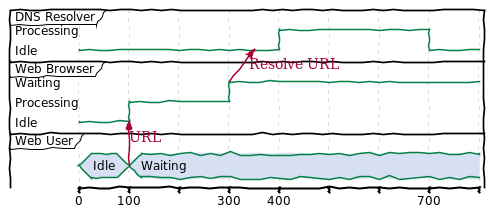Timing Diagram
From Open Risk Manual
Definition
A Timing Diagram is a behavioral UML diagram that can be seen as special case of a Sequence Diagram that focuses on precise timing considerations. Timing diagrams are used to describe the behaviors of objects throughout a given period of time. The timing diagram explicitly shows the state changes of the interaction partners that can occur due to time events or as a result of the exchange of messages. In the timing diagram, lifelines are depicted by a whole area in which states and state transitions can be represented
There are two basic flavors of timing diagram:
- the concise notation, using a simplified signal designed to show the movement of data, and
- the robust notation, using a complex line signal designed to show the transition from one state to another
PlantUML Elements
A PlantUML deployment diagram specifies and shows the following:
- Robust / Concise Objects and associated Lifelines
- @T Notation indicating timepoint
- X is Y Notation (X is object, Y is state)
Example
@startuml skinparam handwritten true robust "DNS Resolver" as DNS robust "Web Browser" as WB concise "Web User" as WU @0 WU is Idle WB is Idle DNS is Idle @+100 WU -> WB : URL WU is Waiting WB is Processing @+200 WB is Waiting WB -> DNS@+50 : Resolve URL @+100 DNS is Processing @+300 DNS is Idle @enduml
